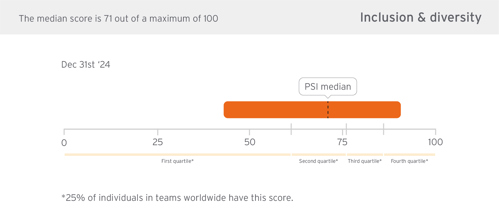Why Inclusion and Diversity Matters
Diversity without inclusion is like inviting someone to a party but not letting them dance. True inclusion means that all voices are not only present but welcomed, respected, and considered. It’s about making space for difference, and ensuring that everyone feels like they belong - regardless of background, identity, or perspective.
In the context of psychological safety, Inclusion & Diversity isn’t just a value. It's a measurable aspect of team behavior.
This domain captures whether team members indicate that differences are accepted, and whether individuals are included in the team dynamic rather than rejected for being different.
High scores suggest that diversity is being translated into collaboration and contribution. Lower scores may point to patterns of disengagement, exclusion, or missed perspectives - all of which limit team learning and performance.
What the Score Means
In the Psychological Safety Index, the Inclusion & Diversity domain captures the extent to which team members report that individuals are equally respected, involved, and valued for who they are and what they contribute.
A high score suggests:
-
Team members report that individuals are recognized and listened to
-
Different perspectives are welcomed and considered in decision-making
- People indicate they can be open about who they are without negative consequences
A low score might reflect:
-
Patterns of bias or favoritism observed within the team
-
Limited representation in leadership or key decision-making roles
- Indications that individuals withhold aspects of their identity or contributions to be accepted by the group
Global Benchmarks

Globally, Inclusion & Diversity scores tend to vary more than other domains. Teams with strong overall psychological safety often score well in this domain, but results frequently show significant variation. Even in high-performing organizations, there can be pockets where team members indicate that certain individuals are excluded or not fully valued.
Benchmarking your team against the global average is useful, but even more important is asking: “Whose perspectives might not be included here, and what could be contributing to that?”
Key Mindsets and Behaviors
Creating an inclusive team culture requires more than good intentions. It starts with a deep commitment to equity and a willingness to listen, learn, and adapt.
Mindsets to adopt:
-
“Everyone has something valuable to contribute”
-
“I may not see what others experience”
-
“My actions shape the culture, even when I don’t realize it”
Helpful behaviors include:
-
Proactively inviting input from quieter voices or underrepresented groups
-
Rotating meeting roles (like facilitator or note-taker) to share power and visibility
-
Being open to feedback about exclusion, even when it’s uncomfortable
Red Flags to Watch For
Low scores in the Inclusion & Diversity domain often come with subtle, but persistent signals. Pay attention to these patterns:
-
“It’s always the same few people who get heard”
-
“I don’t feel like I can speak up without being judged”
-
“We talk about inclusion, but I don’t see it in practice”
-
One or two people dominate conversations or decisions
These signs can indicate that certain perspectives are being privileged over others, even if unintentionally.
Practical Steps to Improve This Domain
If your team wants to strengthen Inclusion & Diversity, focus on daily habits and systemic practices that build inclusion from the ground up.
1. Audit your meeting dynamics
Who speaks most often? Who rarely speaks? Use structured turn-taking or ask people to reflect silently before sharing to level the playing field.
2. Practice identity-safe feedback
When offering feedback, focus on behavior and impact rather than assumptions. Invite others to share how they experience your feedback as well.
3. Learn from lived experience
Host listening sessions, run anonymous pulse checks, or simply ask, “What could we do to make this team more inclusive for you?”
4. Move from representation to participation
It’s not enough to have diverse people on the team. Make sure they are part of shaping strategy, decisions, and the direction of the work.
Wondering how your team measures up in their Inclusion & Diversity?
We offer a simple and effective team assessment tool that provides anonymous insights into your team's psychological safety levels. Both an overall score as in the four domains. This invaluable assessment is the first step towards unlocking your team's full potential.



